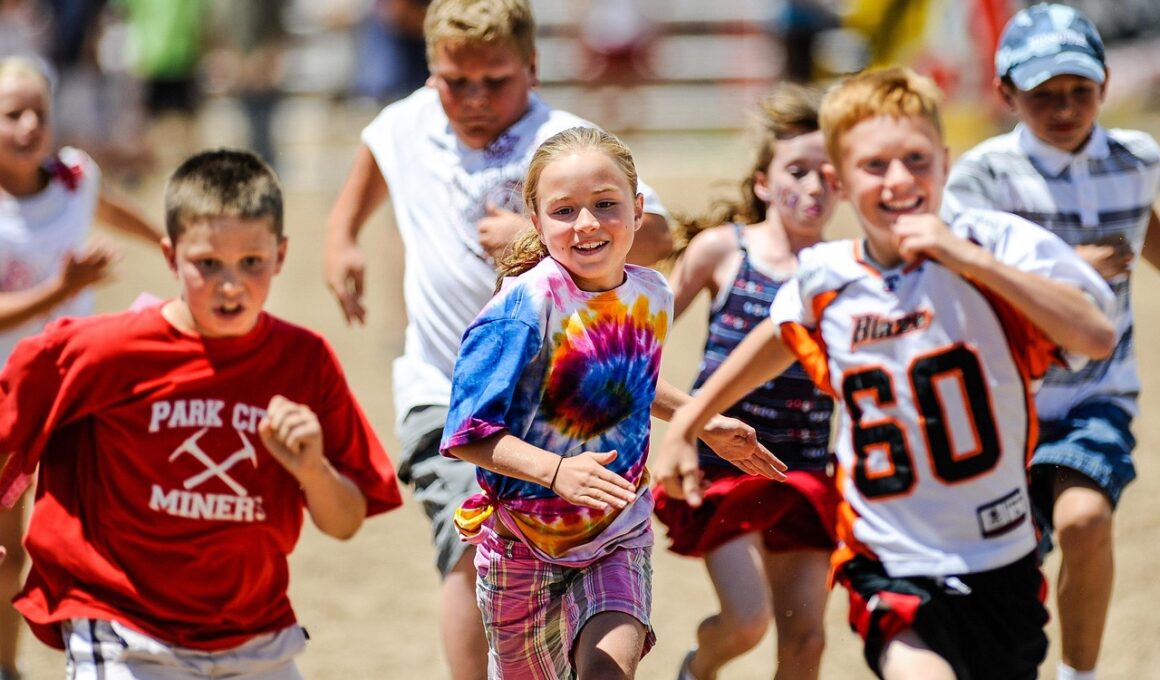Building Speed and Teamwork in Youth Relay Teams
Youth relay races provide an exciting platform for young athletes to showcase their speed and teamwork. These events not only help boost physical fitness but also teach important life skills such as collaboration and commitment. As participants learn to rely on their teammates, the foundation for lasting friendships is built. Relay races require a unique blend of individual talent and collective effort, allowing athletes to shine within the context of a team. For many, the thrill of competition and the adrenaline rush associated with sprinting are thrilling. Coaches also play an essential role in shaping these experiences, guiding athletes through training, and instilling motivation amidst hard work. Developing a relay team is not just about speed; it involves strategic planning regarding relay zones and handoffs. Moreover, consistent practice in synchronizing movements fosters strong team chemistry. Coaches and athletes alike benefit from emphasizing communication and encouragement, which are crucial for success. These races often culminate in group achievements that create cherished memories for participants, reinforcing their passion for the sport. Ultimately, youth relay races cultivate a sense of achievement within individuals as part of a greater whole.
Essential Components of Successful Relay Teams
Successful youth relay teams are built upon essential components, including a well-structured training regimen, effective communication, and a deep understanding of each athlete’s strengths and weaknesses. To maximize performance, it’s important to focus on developing individual skills while also fostering strong team dynamics. Athletes must practice together regularly to ensure that their handoff techniques are smooth and efficient. Incorporating drills that focus on acceleration and deceleration can significantly improve a team’s overall speed. Moreover, understanding the unique baton-passing techniques used in relay races can greatly impact the team’s performance. Each runner should know when to begin sprinting and how to time their handoff accurately with their teammates. Additionally, nurturing team camaraderie through various team-building activities outside of practice can enhance trust and cooperation during races. This bond can often translate into better performance on race day. It’s crucial to create an environment where athletes feel valued and encouraged to express themselves. Parents and coaches alike can support this growth by promoting sportsmanship and celebrating not only victories but also the effort put forth by each participant in the race.
In preparing for relay races, coaches face the challenge of selecting the right individuals for each leg of the race. Allocating roles and understanding the capacities of each athlete can significantly boost a team’s chance of success. The anchor leg, which typically carries the most weight, requires a seasoned sprinter with the mental focus to handle pressure. Meanwhile, the first leg can set a strong tone for the race, making careful selection critical. Training is also about developing specific skills that cater to each leg’s requirements. For instance, the initial runner may focus on explosive starts, while the anchor leg may hone endurance for the final push. In addition, aerobic conditioning and strength training are integral for building endurance while also addressing muscle fatigue. Coaches often devise tailored workout programs to meet distinct needs and goals of the athletes. Additionally, during practice sessions, athletes should participate in simulated race conditions to acclimate themselves to the intensity of competition. Experimenting with different strategies and techniques provides valuable insights that can inform the final lineup on race day, ensuring a unified performance.
The Role of Effective Communication
Effective communication is paramount in relay races for youth teams, serving as the linchpin of successful performances. Athletes must develop cues that signal when to begin their sprint and to ensure a seamless baton exchange. Moreover, consistent verbal and non-verbal communication helps build trust and confidence among teammates. Coaches can cultivate this environment by emphasizing the importance of communication during training sessions, instilling a culture where athletes feel comfortable expressing feedback openly. Practicing handoffs under varied conditions can also improve team members’ ability to communicate during tense moments. Clear and concise instructions during races can guide runners effectively, allowing them to remain focused. It is helpful to cultivate a positive mindset that encourages constructive criticism. Paired with reinforcement, this helps athletes grow and improve collectively. Another strategy involves creating team meeting sessions to discuss strategies and share insights about performance. These discussions play a pivotal role in developing unity, revealing strengths, and uncovering areas for growth. Ultimately, when athletes communicate openly, they are better positioned to support each other, which can lead to improved efficiency and performance, both on and off the track.
Nutrition and recovery play a critical role in optimizing the performance of youth relay teams during the competitive season. For young athletes, maintaining a balanced diet rich in carbohydrates, proteins, and healthy fats supports optimal energy levels. Hydration, too, is vital, especially in the lead-up to races, as it helps maintain stamina and focus. Coaches and parents can assist in encouraging healthy eating habits and educating athletes on the importance of nutrition for performance. Incorporating nutrient-dense foods, such as fruits, vegetables, whole grains, and lean proteins, is crucial for fueling their bodies. On the flip side, recovery practices should not be overlooked. Incorporating adequate rest, stretching, and hydration is vital for muscle recovery, particularly after intense training sessions or competitions. Coaches can facilitate recovery rituals that include rest days and physiotherapy as needed. Introducing relaxation techniques like deep breathing or meditation can also significantly reduce stress and anxiety levels around competition time. When young athletes prioritize their nutrition and recovery, they can enhance their performance through improved endurance while simultaneously cultivating lifelong habits that promote overall wellness and fitness.
Building Team Spirit through Fun
Incorporating fun and engaging activities can significantly enhance team spirit among youth relay teams. Creating a positive environment where young athletes enjoy their time together encourages friendship and cooperation, consequently leading to better performance on race day. Running drills can be turned into friendly competitions, providing fun while reinforcing essential skills. For instance, playful relay games can be integrated into practices to reinforce techniques while ensuring a lighthearted atmosphere. Organizing team outings or social events can further strengthen bonds, allowing athletes to connect outside of practice settings. Developing team chants or cheers fosters unity, giving each member a sense of belonging. Celebrating successes, no matter how small, can promote motivation and a shared sense of accomplishment. Additionally, encouraging creativity through themed races or costume runs can ignite enthusiasm and joy among the athletes. As the team develops camaraderie, these connections will reflect in their performance during competitions. Ultimately, a strong sense of team spirit derived from fun experiences enhances both individual and collective motivation, reinforcing the values of teamwork and collaboration which are essential in relay races.
In conclusion, youth relay races are a vibrant and energetic expression of teamwork. Encouraging young athletes to develop speed, communication, and trust builds a foundation for lifelong skills, extending beyond athletics. Coaches, parents, and athletes all play integral roles in creating a supportive environment that nurtures growth and success. By focusing on both the competitive and experiential aspects of the races, participants can relish the joy of sport while honing their abilities as runners. Further, cultivating a balance between performance and fun fosters resilience and sportsmanship, enriching the overall experience. As these young athletes flourish, the lessons learned in relay racing can empower them, equipping them for future challenges in life. It is essential to appreciate the bond created through shared goals and effort, tying together individual aspirations with collective achievement. Ultimately, youth relay races are a celebration of speed and teamwork, igniting a passion for athletics that can run deep into their futures.


